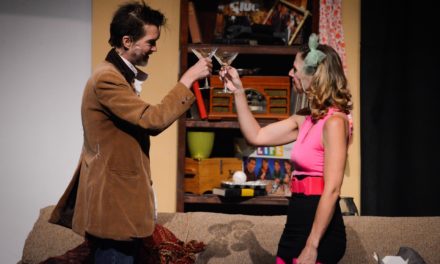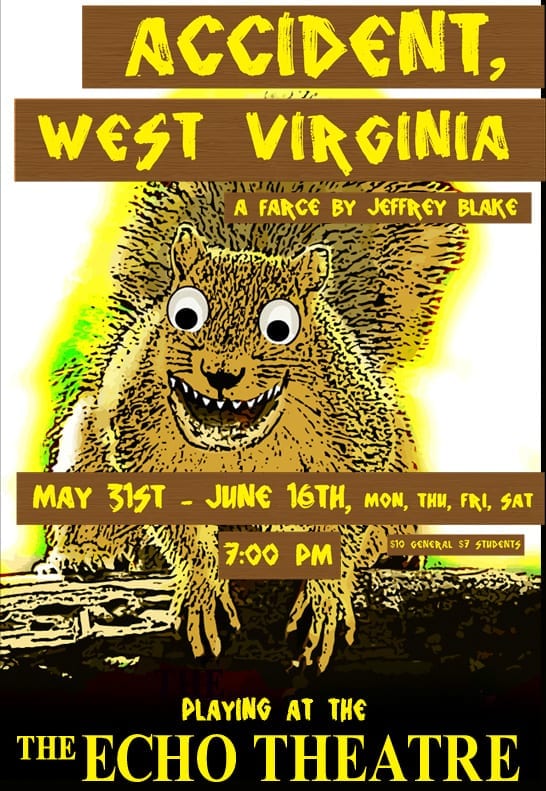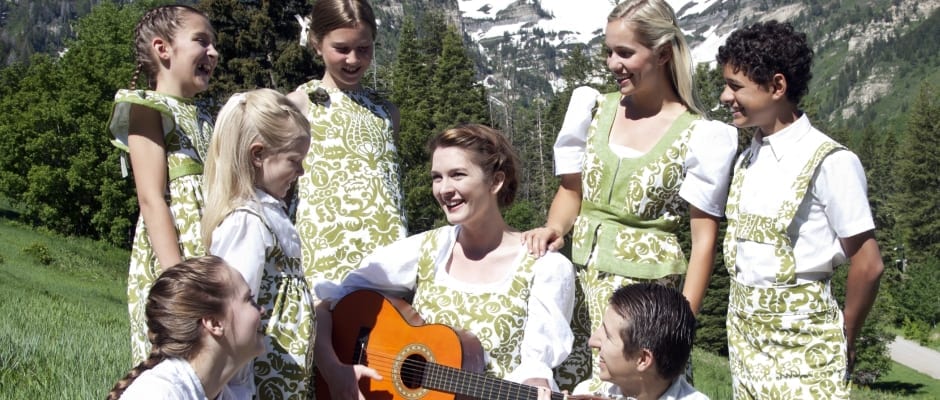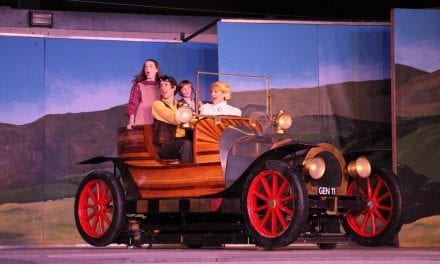CEDAR CITY – One of the best times to come to the Utah Shakespeare Festival is the week the Royal Dramatic Academy of Arts (RADA) brings their touring production all the way from London to Southern Utah. This year’s RADA production is A Midsummer Night’s Dream, directed by Kash Arshad and designed by Sammy Dowson, is playing for six shows only in the Eileen and Allen Anes Studio Theatre on the festival campus. The show is scheduled at 9:30 AM, which may feel early even for most matinee-goers, but it is well worth getting up for. As much as I love the bigger budget festival offerings with their correspondingly bigger production values, there is something magical about a bare bones staging of Shakespeare’s works by a young cadre of actors, that harkens back to Shakespeare’s own time and associated constraints.
Entering the space, there is a costume rack and two hat racks full of an assortment of simple costume pieces, a guitar, and a few loose props, all hedged in by a row of foresty greenery strewn across the floor demarcating the back of the playing space. The space itself is the set of whatever USF matinee is scheduled that day, which on the day I attended, was the 1960s hotel room of Martin Luther King, the setting of The Mountaintop. As such, the worn hotel carpeting becomes both the Athenian court and the forest floor—a magical transformation in itself.
It pays to arrive early for the RADA show as one of the highlights is the preshow, where the entire cast, heralded by a fanfare and accompanied by an actor playing a cajon box drum, chaotically interacts with the audience. Lysander makes his way around the studio space, asking audience members if they’ve come for the Duke’s wedding or if they’ve seen his beloved Hermia, while the clownish mechanicals are searching for actors to join their troupe amongst the theatre-goers. This preshow was one of my favorite aspects of last year’s RADA production (The Comedy of Errors) and I was delighted to see it utilized again this year. This interaction serves to set the fun, casual tone of the production, pulling the audience into the world of the play.
The cast of 10 RADA students remain on stage at the periphery almost the entire show, a convention which both establishes that we are all willing participants in a theatrical experience and helps to focus our attention on the moment at hand as the actors not in the scene are active spectators themselves. These actors play all the many characters and as such, quickly establish character changes with the addition/subtraction of a costume piece or two. It quickly became an interesting convention to take in.
The costumes themselves, supervised by Laura Conroy, are simple and eclectic. There are several references to the lovers’ Athenian garments in the text, and although their dress is modern, the costumes, especially the women’s shirts and skirts, evoke in a small way the image of flowy Grecian chitons. The mechanicals costuming is very fun. From the mishmash work-ware to the simple hat adorned with donkey ears for Bottom’s transformation, to the silly costumes for the play within the play, they are delightful. My favorite costume choice is the small role of Philostrate, played by Harry Berry, who sports a bright yellow suit and sunglasses while playing the drum.
A Midsummer Night’s Dream is simultaneously one of Shakespeare’s most accessible scripts and also one of the wildest. With royalty (both mortal and fey), fairies, lovers, spells and clowns converging in the forest during the midsummer solstice, a time traditionally associated with mad and foolish behavior, anything is possible. RADA’s production, does indeed deliver on this them. The near constant movement and shifting blocking within the production succeeds in heightening the energy and the tension which was at times dizzying. The blocking and stage conventions are clever, with movement credited to Daniel Bowerbank. In particular, the way the cast uses the greenery to create a forest that envelops and extrudes characters as required is ingenious. When this forest then extends itself diagonally across the playing area, causing the mechanicals to have to claw their way through as the enchanted forest smacks them about is brilliant.
Sound, designed by Jonathan Armitage, is effectively used throughout the production. In addition to the box drum there was also a pipe, a guitar and even a saxophone played by characters (although the latter only briefly) throughout. The forest also comes alive with sounds of birds, bugs and other critters emanating from the actors themselves. There are several moments when various characters sing or play music to great effect. These organic sounds enhance the production greatly, and I’d have loved to see even more of that convention utilized. It was such a brilliantly theatrical technique.
RADA produces excellent and impeccably trained young actors, and this touring troupe is no exception. Although I didn’t have an opportunity to attend a talk back with the cast this year, last year’s RADA troupe talked about how they are trained to interact with the text. They described a fine balance between being intimately familiar with the rhythm of the meter, and completely trusting the text—trusting Shakespeare himself. As the bard tells us in Hamlet, the words must be allowed to trip off the actors tongue, and trip they do with this skillful ensemble. Of particular note within the cast are Berry’s outlandish and distinct character choices in both Egeus and Philostrate, Daniel Holden’s comic timing as Starveling’s sincere “Wall”, and Yoav Besorai’s endearing performance as Bottom, who is at once ridiculous and endlessly likeable.
RADA’s Midsummer is fun and magical and creative—all things one would hope in such a production. If you didn’t make it this year, be sure and plan your Utah Shakespeare Festival excursion around the RADA tour next year —you won’t be disappointed.
A Midsummer Nights Dream plays at 9:30 AM, through August 3rd in the Eileen and Allen Anes Studio Theatre (101-199 University Blvd, Cedar City). Tickets are $20. For more information, visit bard.org.




